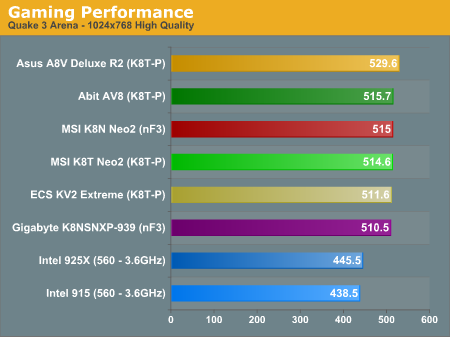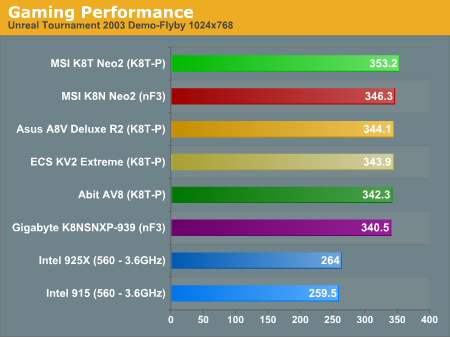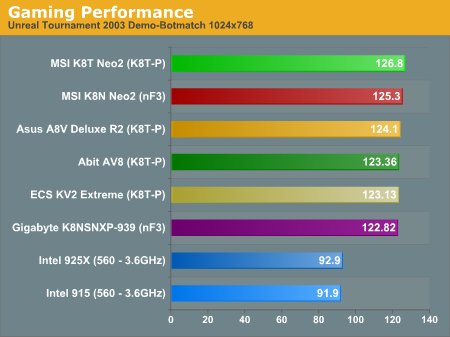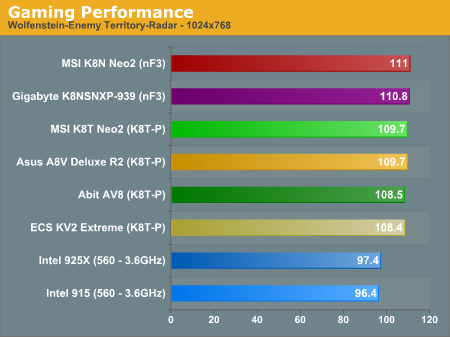Socket 939 Roundup: Battle at the Top
by Wesley Fink on July 30, 2004 8:00 AM EST- Posted in
- Motherboards
DirectX 8 & OpenGL Gaming Performance






DX8 and OpenGL games show the same consistent performance between the VIA and nVidia 939 chipsets except for X2 and RCW-ET. X2, a Direct X 8.1 game with demanding T&L (transform and lighting effects), performs best on a VIA chipset, while Wolfenstein-Enemy Territory, an OpenGL game, is best on nForce3. We do plan to take a closer look at Halo, X2, and RCW-ET performance when we can repeat the tests with an ATI X800 XT video card.
Generally, the domination of the Socket 939 results compared to Intel's top Pentium 4 560 (3.6GHz) on the top 925X chipset is not a pretty picture for Intel, in DX9, DX8, or OpenGL. Clearly, the Athlon 64 processors in general, and the Socket 939 in particular, continue their domination of Gaming benchmarks.










83 Comments
View All Comments
Wesley Fink - Sunday, July 25, 2004 - link
In compiling benchmarks for the upcoming 925X roundup, we realized we had used a different setup for our 925X AutoGK tests in this review than the setup for 939. This caused lower results with the 925X than we achieved with the same setup.AutoGK results have been corrected, and now show essentially the same encoding performance with the DivX 5.1.1 codec on both Intel 560 and AMD FX53 processors with a slight advantage to Intel. Tests with the Xvid codec show almost the same equivalent results with a slight tilt toward AMD.
Graphs and review text have been corrected to reflect the corrected encoding results. Current AutoGK settings are 'no audio' and default '2CDs (1400Mb)' output size. We install and select Divx 5.1.1 instead of the included Xvid codec. Ripping is from the original DVD file for Chapter 9 of "Sum of All Fears". At present we use the latest release version of AutoGK, which is 1.25, though there are beta versions available through 1.48.
Wesley Fink - Saturday, July 24, 2004 - link
#61 - You are mistaken in saying we used the SAME CPU in comparing 875 and 925X. If you will check our review at http://www.anandtech.com/cpuchipsets/showdoc.aspx?... you will see that our comparison #2 was a 3.2E on the 925X to a 3.2 Northwood on 875. In fact we got a lot of flak from some readers because we didn't use the same CPU. We felt then, and still feel, the fairest comparison was the 875 with Northwood to a similar speed 775 with Prescott.Our options on 939 are a 3500+ (512k cache) at $500, a 3800+ (512k) at $700, or a FX53 (1MB cache) at $763. AMD is expected to announce price reductions soon, but those are our current 939 choices. Given those 3 options with prices beginning at $500, the FX53 is an easy recommendation.
Staples - Saturday, July 24, 2004 - link
Arrggg.Interesting numbers but I hate the fact that Anandtech keeps using the FXxx and only the FXxx. Sure I can now see that AMDs best wins over Intel's best but that is not really practical because I will never buy an FXxx. I want benchmarks between stuff the average consumer is going to buy. Most people including me are struck between.
875/865 and Northwood (non EE)
925x/915 and a Presscott (non EE)
AMD64 754 vs 939 chips and chipsets but NOT the FX series.
These testbeds have only added to a string of Anandtech blunders. Remember the 925x review which was supposed to compare the 875 against the 925x? Well to elimate as many variable as possible, you use the SAME cpu, not a Northwood in one and a Presscott in the other.
I love Anandtech and I usually only come here for reviews but I really wish the staff would put more scientific thought into their testbeds. I will never buy an FX series processor and neither will most people because they cost way too much. At least you can throw in a testbed or two of some processors that the common man will actually buy.
Hope this critical post circulates with the staff and is actually taken into consideration.
PrinceGaz - Saturday, July 24, 2004 - link
Would there really be any point in providing FSB adjustments above 300 on say the MSI K8N mobo?As far as I know there are only two reasons for increasing the FSB-- increasing the memory speed, and increasing CPU core speed on non-FX chips which don't have an upwardly adjustable multiplier.
Theres no point in increasing the FSB beyond the point where the memory can run at a 1:1 ratio, and your fastest DDR550 memory was only able to hit 290FSB (DDR580). Unless faster DDR memory becomes available (which seems unlikely as the focus for speed will switch to DDR2), then 300FSB is more than enough.
The only other reason for increasing the FSB would be if you were seriously overclocking a CPU. 300FSB is enough for a 50% overclock which is more than enough for anyone. Maybe if someone got the liquid nitrogen out they could take a 3500+ beyond 3.3GHz, but I'm sure those sort of people would have got the fastest FX instead so they could raise the multiplier and not have to worry about bus speeds holding them back.
Myself, I'm sure I'm not alone in holding out for S939 boards with PCI-Express support. And maybe a 90nm Athlon 64 if they arrive before the end of the year. And if the MSI K8N whatever that is available then is as good as the current ones, that'll probably be what I get.
Wesley Fink - Saturday, July 24, 2004 - link
#58 and others -The nForce3-250Gb and NForce3 Ultra do not provide a full integrated Gigabit LAN in the chip. They provide a MAC (Media Access Controller) and a dedicated Gigabit Ethernet PORT on the chip (nF30250GB and nF3-Ultra). This is then interfaced to any number of PHY (Physical Layer) Gigabit Ethernet Controllers.
To quote the nF3 Tech paper from nVidia:
"NVIDIA nForce solutions provide an industry-standard Reduced Gigabit Media Independent Interface (RGMII) for attachment of the 1000BASE-T Gigabit Ethernet PHY. The open, nonproprietary interface lets system designers interface the NVIDIA solution to Ethernet PHY from a variety of vendors. Consumers and enterprises all benefit from a broad range of competitive PHY offerings."
This means seeing a listing of a particlular Gigabit Eternet Controller does NOT mean an nForce3 board is not using the on-chip Ethernet.
If you look closely at the specs for the MSI, the Marvell LAN chip is spec'ed as PHY. It is also worth noting that the Marvell 88E1111 is the same chip nVidia used in their Reference designs for the nF3-250Gb and nF3-Ultra Reference Boards, but other brands can be used as you can see in the nVidia literature.
darklight0tr - Saturday, July 24, 2004 - link
Wesley,I was wondering how you determined that the MSI K8N Neo2 used the onboard nVIDIA LAN.
If you go to the MSI website and look at the specs for the board, it says that the Dual LAN ports are controlled by Realtek and Marvell controllers, respectively. The nVIDIA LAN is not used.
Is the board you tested different than the board listed on the MSI website?
Also, is there any particular reason that no nForce3 Ultra motherboards use the onboard nVIDIA LAN?
Drayvn - Friday, July 23, 2004 - link
I thought it was pretty widely known that a nVidia graphics card will be totally optimized on a nVidia mobo, so when testing the X800 on an nForce chipset, ull get lower performance numbers wouldnt u, and so wouldnt that muck up the test results?#53, it still does show how well the FX-53 does against a product that is coming out in 2 months doesnt, and this 3.6Ghz is 1.2 Ghz faster and still its being outperformed, so isnt this telling u that the FX-53 is the system to go for? No need to get upset about the intel chip not being out, get the FX-53 now!
vie2233hil - Friday, July 23, 2004 - link
has anybody seen A8V revision 2 anywhere?Anemone - Friday, July 23, 2004 - link
ECC while nice, doesn't seem to come in any high performance modules that aren't registered. And we know these boards don't take registered memory, which would make using ECC memory translate to using something at PC3200 or below.Am I incorrect?
normteke - Thursday, July 22, 2004 - link
I'm pretty new to overclocking. So when you guys say you can bump the fsb to 290 with a lower multiplier and a 1:1 memory ratio, does the memory now have to run at 290 as well, or can it stay at default 200 to keep those tight 2-2-2 memory timings? How exactly does that work?